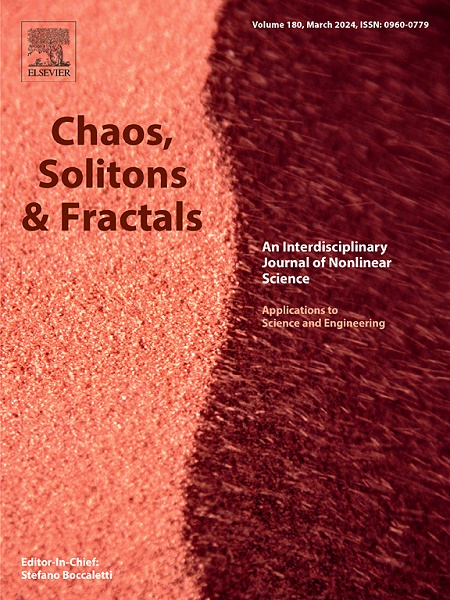Multihump fundamental solitons in the multi-component Mel’nikov system
IF 5.6
1区 数学
Q1 MATHEMATICS, INTERDISCIPLINARY APPLICATIONS
引用次数: 0
Abstract
In this paper, the multihump fundamental -soliton solution for the multi-component Mel’nikov system is derived by combining the Hirota bilinear method with the variable separation approach. In this solution, each short-wave component contains arbitrary functions of the variable . By assigning different functional forms to these arbitrary functions, various types of multihump soliton solutions, including chaotic, fractal, and folded solitons, can be generated, thereby significantly enhancing the diversity of multihump solitons. Furthermore, the study demonstrates that for the arbitrary functions in the same component of the multihump multi-soliton solution, selecting different functional forms leads to hybrid solutions with solitons of different waveforms, such as dromion-like solitons appearing alongside linear solitons, and curved solitons coexisting with serpentine solitons. This finding provides an effective approach for exploring the interaction dynamics among different types of multihump solitons in nonlinear physics.
多分量梅尔尼科夫系统中的多驼峰基本孤子
本文将Hirota双线性方法与变量分离方法相结合,导出了多分量Mel 'nikov系统的多峰基本n孤子解。在该解中,每个短波分量包含变量y的N个任意函数,通过赋予这些任意函数不同的函数形式,可以生成各种类型的多驼峰孤子解,包括混沌孤子、分形孤子和折叠孤子,从而显著增强了多驼峰孤子的多样性。此外,研究表明,对于多驼峰多孤子解的同一分量中的任意函数,选择不同的函数形式会导致不同波形孤子的混合解,例如类激子孤子与线性孤子共存,以及弯曲孤子与蛇形孤子共存。这一发现为探索非线性物理中不同类型多驼峰孤子之间的相互作用动力学提供了一种有效的方法。
本文章由计算机程序翻译,如有差异,请以英文原文为准。
求助全文
约1分钟内获得全文
求助全文
来源期刊

Chaos Solitons & Fractals
物理-数学跨学科应用
CiteScore
13.20
自引率
10.30%
发文量
1087
审稿时长
9 months
期刊介绍:
Chaos, Solitons & Fractals strives to establish itself as a premier journal in the interdisciplinary realm of Nonlinear Science, Non-equilibrium, and Complex Phenomena. It welcomes submissions covering a broad spectrum of topics within this field, including dynamics, non-equilibrium processes in physics, chemistry, and geophysics, complex matter and networks, mathematical models, computational biology, applications to quantum and mesoscopic phenomena, fluctuations and random processes, self-organization, and social phenomena.
 求助内容:
求助内容: 应助结果提醒方式:
应助结果提醒方式:


